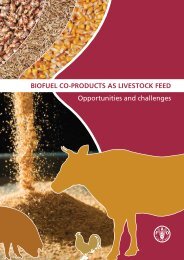Distillers Grains Feeding Recommendations. - Distillers Grains By ...
Distillers Grains Feeding Recommendations. - Distillers Grains By ...
Distillers Grains Feeding Recommendations. - Distillers Grains By ...
You also want an ePaper? Increase the reach of your titles
YUMPU automatically turns print PDFs into web optimized ePapers that Google loves.
ule applies for the concentrations of all the other nutrients(fat, fiber, protein, phosphorus, etc.)The second factor to have a major impact on DDGS nutrientconcentrations is processing methods. Type of yeastused, fermenting and distillation efficiency, drying temperatureand time, and amount of solubles blended with thedry material all affect the nutrient concentrations in DDGS.Recent research at the University of Minnesota also hasshown that DDGS from the new-generation ethanol plantsin South Dakota and Minnesota has higher nutrient concentrationsthan DDGS from traditional ethanol plants.Table 1 shows the nutrient composition of traditional and“new generation” DDGS.Table 1. Nutrient composition of two sources of DDGS(as-fed basis).Traditional SD/MNNutrient DDGS DDGSCrude Protein 27.7% 26.8%Total lysine .62% .74%Digestible lysine .29% .39Crude fat 8.4% 9.7%Crude fiber 9.1% 7.8%Calcium .20% .05%Total phosphorus .77% .79%Digestible phosphorus .59% .71%Metabolizable energy, kcal/lb 1282 1633Table 1 shows large differences in nutrient concentrationsfor the processing methods, especially for two of the mostcritical nutrients: digestible lysine (34.5%) and digestiblephosphorus (20.3%). The question then becomes “Whatvalues do I use when formulating swine rations?”The best answer is to properly sample each load of DDGSyou get and analyze for lysine and phosphorus. Thenmultiply those values by their digestibility coefficients(lysine = .53; phosphorus = .90) to get the amountdigestible of each nutrient.For example, if a sample of DDGS contained .80% totallysine and .78 total phosphorus, you’d multiply .80% times.53 to get a digestible lysine value of .42%. Then, multiply.78% by .90 to get a digestible phosphorus concentrationof .702%. These are the values you need to use when balancingswine rations.If analyzing each load of DDGS is not feasible, the nextbest thing to do is to visit the plant you purchased the2DDGS from and find out the nutrient range of its productover the last 6 months. To avoid a potential nutrient deficiency,it is then best to select a value at the lower end ofeach range to use when formulating.If that data is not available, consider changing suppliers oruse the values for traditional DDGS.Another method to reduce nutrient variation is to develop aDDGS specification sheet for nutrient levels and physicalcharacteristics, and then only buy DDGS from plants thatwill guarantee meeting those specifications. However, youare responsible for periodic testing to ensure your specificationsare being met. Table 2 is one example of such asheet.Table 2. Specifications for DDGS for swine diets.Moisture maximum 12%Crude protein minimum 26.5%Crude fat minimum 10%Crude fiber maximum 7.5%Color goldenSmell fresh, fermented, pleasant cereal odorBulk density 34 – 37 lb/cubic footParticle size coarse = 10% maximum on a 2000-mesh screenfine = 15% maximum on a 600-meshscreen and panMycotoxinsMycotoxins are produced by molds either in the field orduring storage. They can severely impact pig and sow performance.While there are many different mycotoxins,zearalenone and vomitoxin (DON) are the main ones ofconcern for South Dakota pork producers.Unfortunately, the fermentation process does not destroymycotoxins. In fact, just as it does for lysine and othernutrients, it concentrates the mycotoxins threefold. If corncontaining 1 ppm zearalenone is delivered to an ethanolplant, the resulting DDGS will contain 3 ppm zearalenone.Since the maximum inclusion rate of both mycotoxins is1 ppm in the total diet, it does not take a large amount ofmycotoxins to cause problems, especially for sows.This is more of a problem if the ethanol plant is purchasingdamaged grains or if it has been a year in which there hasbeen a mycotoxin problem in the corn in the field.
















